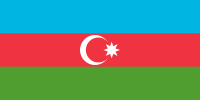
Azerbaijan (pronounced /ˌæzərbaɪˈdʒɑːn/ az-ər-bye-JAHN; Azerbaijani: Azərbaycan), officially the Republic of Azerbaijan (Azerbaijani: Azərbaycan Respublikası), is one of the six independent Turkic states in the Caucasus region of Eurasia. Located at the crossroads of Eastern Europe and Western Asia, it is bounded by the Caspian Sea to the east, Russia to the north, Georgia to the northwest, Armenia to the west, and Iran to the south.
The exclave of Nakhchivan is bounded by Armenia to the north and east, Iran to the south and west, while having a short borderline with Turkey to the northwest. The majority-Armenian populated Nagorno-Karabakh region in the southwest of Azerbaijan declared itself independent from Azerbaijan in 1991, but it is not diplomatically recognized by any nation and is still considered a de jure part of Azerbaijan.
Azerbaijan has diplomatic relations with 158 countries so far and holds membership in 38 international organizations. It holds observer status in the Non-Aligned Movement and World Trade Organization and is a correspondent at the International Telecommunication Union. The Azerbaijani diaspora is found in 42 countries and in turn there are dozens of centers for ethnic minorities inside Azerbaijan, including the (German cultural society “Karelhaus”, Slavic cultural center, Azerbaijani-Israeli community, Kurdish cultural center, International Talysh Association, Lezgin national center “Samur”, Azerbaijani-Tatar community, Crimean Tatarssociety, etc.). On 9 May 2006 Azerbaijan was elected to membership in the newly established Human Rights Council by the United Nations General Assembly. The term of office began on 19 June 2006.
Azerbaijan, a nation with a majority Turkic and Shi‘ite Muslim population, is a secular and a unitaryrepublic with an ancient and historic cultural heritage. Azerbaijan was the first successful attempt to establish a democratic and secular republic in the Muslim world.
Azerbaijan is one of the founder members of GUAM and the Organisation for the Prohibition of Chemical Weapons, and joined the Commonwealth of Independent States in September 1993. A Special Envoy of the European Commission is present in the country, which is also a member of the United Nations, the OSCE, the Council of Europe, and the NATO Partnership for Peace (PfP) program.
By the 9th century CE it had come under Turkish influence, and in ensuing centuries it was fought over by Arabs, Mongols, Turks, and Iranians. Russia acquired what is now independent Azerbaijan in the early 19th century. After the Russian Revolution of 1917, Azerbaijan declared its independence, but it was subdued by the Red Army in 1920 and was incorporated into the Soviet Union. It declared independence from the collapsing Soviet Union in 1991.
Azerbaijan has two geographic peculiarities: The exclave Naxçivan (Nakhichevan) is separated from the rest of Azerbaijan by Armenian territory. Nagorno-Karabakh, which lies within Azerbaijan and is administered by it, has a Christian Armenian majority. Azerbaijan and Armenia went to war over both territories in the 1990s, causing many deaths and great economic disruption. Though attempts at mediation were made, the political situation remained unresolved.
Azerbaijani culture has developed as a result of many influences. Today,Western influences, including globalized consumer culture, are strong.
Azerbaijan folk consists of Azerbaijanis, the representative part of society, as well as of nations and ethnic groups, compactly living in various areas of the country. Azerbaijani national and traditional dresses are the Chokha and Papakhi. There are radio broadcasts in Russian, Armenian, Georgian, Kurdish, Lezgin and Talysh languages, which are financed from the state budget. Some local radio stations in Balakən and Xaçmaz organize broadcasts in Avar and Tat. In Baku several newspapers are published in Russian, Kurdish (Dengi Kurd), Lezgin (Samur) and Talysh languages. Jewish society “Sokhnut” publishes the newspaper Aziz.
The Kura River valley is the region’s chief agricultural zone. Wheat, barley, corn, fruits and vegetables, wine grapes, and potatoes are the leading food crops, and cotton, silk, and tobacco the foremost industrial crops. The subtropical Lankaran Lowland produces tea and rice. The Absheron peninsula is one of the richest oil regions of the world. Although production of Caspian Sea oil and gas had declined for several years, it began growing again in the late 1990s under production-sharing agreements with multinational corporations. The republic’s other mineral resources include natural gas, iron ore, copper, lead, zinc, limestone, pyrites, cobalt, and alumina.
Widespread salt springs have enabled health resorts to flourish. Among the chief manufactures are petroleum products, oilfield equipment, steel, chemicals and petrochemicals, and textiles. The old craft of carpet weaving is still practiced. Azerbaijan’s main trading partners are Italy, Russia, and Turkey.
Notes from Wikipedia and Answers.com









